Coaxial Cable vs Ethernet: Connectivity Facts
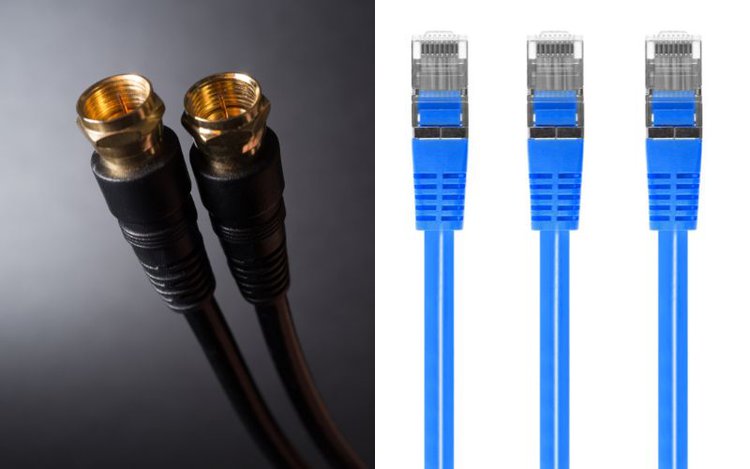
- Coaxial cables are better for cable TV and CCTV, while Ethernet cables are ideal for internet and network cabling.
- Coaxial cables are more durable and support longer distances. Ethernet cables offer higher bandwidth and faster internet connections.
- Ethernet has progressed from coaxial to twisted pair cables (Cat-5 to Cat-7), with newer versions supporting higher speeds and bandwidth.
This article demystifies the technical jargon, laying out the pros and cons of coaxial and Ethernet cables, and empowers you to make an informed decision that suits your wired network needs.
Stay tuned as we untangle the cords that keep you connected.
Quick Navigation
What Is a Coaxial Cable?
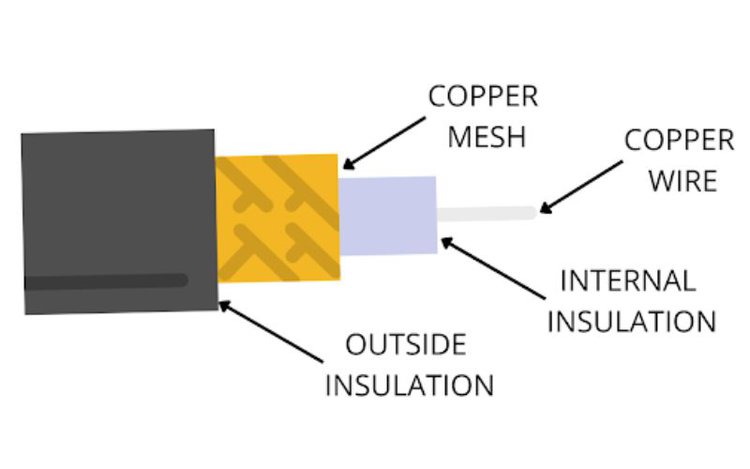
A coaxial cable, also called “coax,” is an electrical cable. It comprises an electrical conductor covered by a circular conducting shield. “Coaxial” denotes the inner conductor.
A dielectric (insulating substance) separates the conductor and the shield. Several coaxes also sport a protective jacket or external sheath.
Coaxial cables have controlled cable and connector dimensions to offer the continuous, precise spacing required to perform transmission line duties effectively and efficiently.
The signals in the electromagnetic field in a coaxial cable exist only between the outer and inner conductor space. This permits running coaxial cords installed near metal items and not experiencing power losses identified with such transmission lines.
The cable also protects the signal from outside electromagnetic interference.
Build
Coaxial cables transmit electrical signals employing its inner conductor—usually solid or stranded (more flexible) copper, or a steel wire with copper plating.
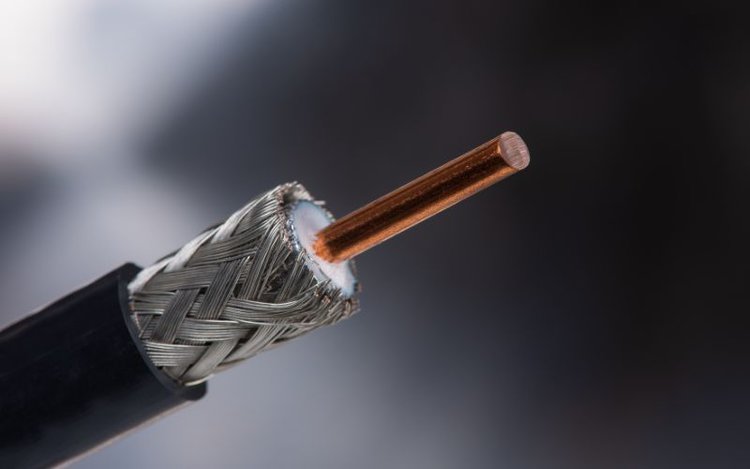
The internal shield is typically a layer or two (or up to four layers) of interwoven metallic tape and metallic braid. The four or quad-shield cables employ four rotating levels of braid and foil. Some shields could be solid metal tubes that do not bend acutely.
The conductor could be plated with silver to achieve improved high-frequency functioning. Copper-plated coaxial wires are commonly used for cable TV applications.
The insulator enveloping the inner conductor could be foam, solid plastic, or pure air with spacers to assist the internal wire.
The dielectric insulator’s properties ascertain some of the cable’s electrical attributes. Polyethylene (PE) is a commonly used insulator in lower-loss (better shielding) cords. Solid Teflon (PTFE) is exclusively used in plenum-rated cords.
Types/Standards
Coaxial cables come with a characteristic impedance, ranging from 50 to 93 ohms.
Fifty-two and 75 are the other two impedance figures. Impedances 50 and 52 are commonly used, with the other impedances employed for specific applications.
The radiofrequency (RF) space employs names for coaxial cables, denoting standard or type. RG-6, for instance, is a standard type commonly used in homes. The abbreviation “RG” stands for “radio guide.”
Although “RG” standards are now considered obsolete, they are still used to denote coax cables due to how synonymous the abbreviation has become with the cable type. RG-7, RG-8, RG-9, RG-11, RG-56, RG-60, etc., are other RG designations for coax cords.
With the different types, the physical dimensions and electromagnetic capabilities vary. For instance, the impedance figures change. Similarly, the cable’s diameter numbers also shift.
Use Cases
A coaxial cable is typically employed in telephone trunk lines, broadband internet cabling and cable TV signal transmission, connecting radio receivers and transmitters to their antennas, etc.
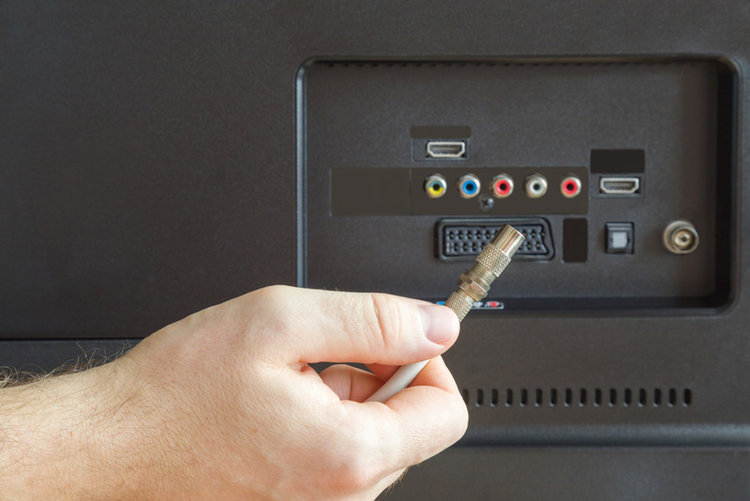
Coax can be used both inside and outside a house.
Based on the cable’s length, the use cases could change. For instance, long-distance coaxes have been used for decades in radio and television network connections. Shorter coaxials help transport cable TV signals to most television receivers.
RG-6 and RG-11 are the most commonly used coax cable types. An RG-6 is typically used for lengths spanning 150 feet or less.
RG-11 cables can be longer, thanks to their improved performance over greater distances.
As mentioned earlier, the 50 and 52-ohm coaxes are primarily used for commercial and industrial radio frequency applications (two-way).
Seventy-five-ohm cables are typically used for broadcast radio and TV. Broadband cables used inside homes have a 75-ohm impedance.
What Is an Ethernet Cable?
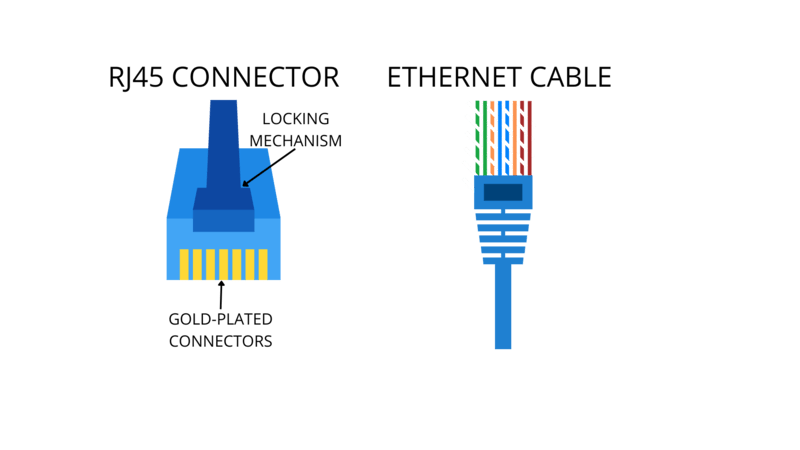
An Ethernet cable, also called “network cable,” is a cable that connects a computer (desktop or laptop), gaming console, etc., to the internet.
Basically, it provides a LAN (local area network) or wired internet connection. Such hard-wiring a device to an internet router was the norm before Wi-Fi ushered in wireless connections and became the standard.
Ethernet cords employ RJ-45 connectors and can be up to 328 feet (100 meters) in length. They look pretty similar to those classic landline phone wires but are bigger.
Design/Build
Kindly note that “Ethernet” is a communications standard and not the name of the cable per se. The specification can use coax, twisted pair, or fiber optic cables. The first sets of Ethernet cables were coaxial cables.
Modern Ethernet cables are twisted pair cords made of four insulated conductor pairs. Each pair’s conductors are curled around each other.

The cables are twirled at different rates or points, ensuring the cable’s conductors do not or are rarely oriented parallelly to the other conductors within or outside the line. This twisting design helps avoid electromagnetic interference-induced signal loss or noise.
The individual wires are color-coded (usually orange, blue, green, and brown) to identify which wire goes with what.
The cable has an external protective sheath that shields the cable’s insides. The covering could be made of a fluorinated ethylene polymer or high-quality PVC.
Use Cases
An Ethernet cable is primarily used in or is synonymous with wired internet connections.
Although today, Wi-Fi is the standard, it cannot match the stability and speed of an Ethernet connection. This is why routers continue to come with an Ethernet cable despite being Wi-Fi capable.
Ethernet cables usually run from a computer to a router or from a router to a modem. The line also connects devices like scanners and printers to a network. Any building (home, hospital, school, office, etc.) that needs the internet has Ethernet cables.
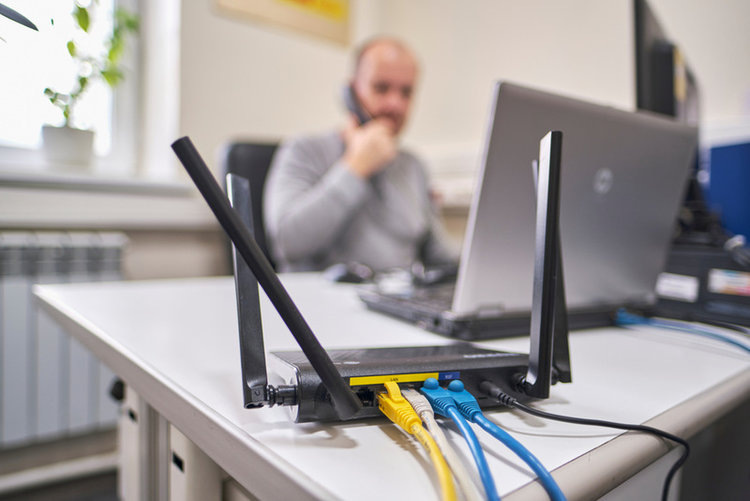
Stability and Speed
For gamers, an Ethernet connection is a boon as the reduced connection latency translates to faster loading times and less lag in multiplayer games. The internet speed or connection loss identified with a Wi-Fi connection is not an issue with Ethernet.
Also, the Ethernet cable connector plugs into its port fairly snugly and locks into place. Unplugging the cable accidentally and losing an internet connection is a sporadic occurrence with Ethernet.
Using an Ethernet Cable
To use an Ethernet cable, plug one end of the cord into the terminal device’s (e.g. your computer) Ethernet port and the other end into your router. After both sides are plugged in, your computer recognizes the wired connection.
If your computer or another device is connected to the Wi-Fi and you plug in the Ethernet wire, it may sometimes not switch to Ethernet readily. You might have to change the network option settings on your device and instruct it to use the Ethernet connection, not Wi-Fi.
Kindly note that an Ethernet cable has no downstream or upstream ports, meaning you can plug either of the two ends into your computer or router.
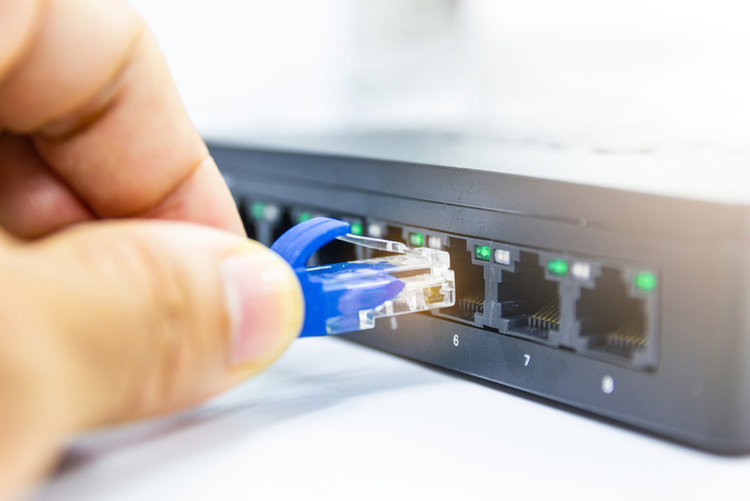
Most devices that can connect to the internet through wires have an Ethernet port. If your device doesn’t (like modern MacBooks or the Nintendo Switch), grab an adapter like this ABLEWE USB 3.0 to Ethernet Adapter . Here’s a USB-C variant: UGREEN USB C to Ethernet Adapter .
Routers usually come with multiple Ethernet ports to connect several devices simultaneously. But if you need to connect more devices than the router can accommodate, consider a network switch.
These switches come with different Ethernet port configurations. The TP-Link TL-SG105 is a five-port network switch, for instance. Here is a 24-port option: TP-Link TL-SG1024 .
Ethernet Cable Categories
Ethernet cords are usually labeled Cat-5, Cat-6, or Cat-5e. “Cat” stands for “Category,” and the figure denotes the specification the cable supports.
There were Cat-1 to Cat-4 categories. Those, however, are now obsolete or not technically up there to meet Ethernet standards.
Cat-5 cables are pretty old too, and not usually employed for fresh installations. But they are not too outdated to uproot existing Cat-5 wires and replace them with a Cat-6.
Cat-5 cables support up to 100 Mbps of data transfer speeds and 100 MHz bandwidth. They can also support up to 1000 Mbps or 1 Gbps speeds, but the lack of shielding is a deterrent, hampering speeds in the real world.
The shielding safeguards the line from external electromagnetic interference. In other words, the longer the cable, the lower the transfer speeds.
Cat-5e is not an official category but attracts attention due to its improvements over Cat-5. It supports 1 Gbps of transfer speeds and resists external noise better.
Cat-6 cable is a significant upgrade over Cat-5 and Cat-5e. It supports 1 Gbps speeds. At shorter distances (up to 121 feet or 37 meters), however, it can support up to 10 Gbps, thanks to the 250 MHz bandwidth and improved shielding.
There’s also Cat-6a, a more advanced Cat-6 specification version that supports 500 MHz bandwidth and 10 Gbps data transfer speeds up to 328 feet (100 meters).
And then there’s Cat-7, which is more proprietary and, therefore, not as popular. They are also not TIA-approved. TIA is “Telecommunications Industry Association.”
Cat-7a improves upon Cat-7, supporting a maximum of 40 Gbps and 100 Gbps speeds up to 164 feet (50 meters) and 49 feet (15 meters), respectively. Cat-7a is also proprietary and, therefore, not widely used.
| CATEGORY | SPEED | BANDWIDTH |
| Cat 5 | 100 Mbps | 100 Mhz |
| Cat 5e | 1 Gbps | 100 Mhz |
| Cat 6 | 1 Gbps | 250 Mhz |
| Cat 6a | 10 Gbps | 500 Mhz |
| Cat 7 | 10 Gbps | 600 Mhz |
| Cat 7a | 40 Gbps | 1000 Mhz |
Coaxial vs. Ethernet: Side-by-Side Comparison
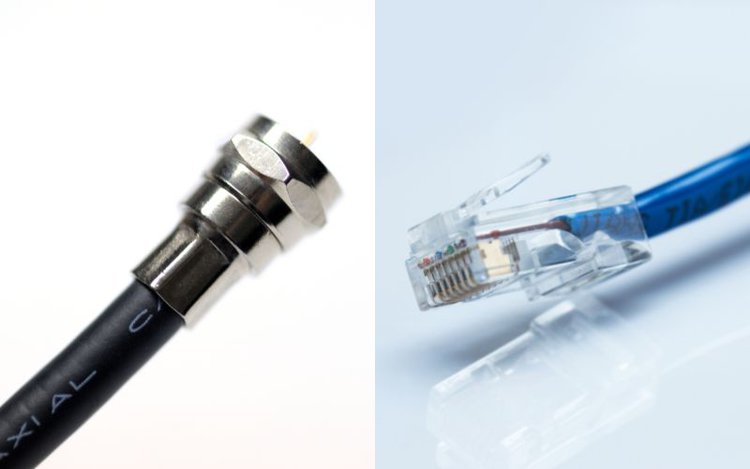
Both coaxial and Ethernet cables are networking cords. But there are variations between the two, as elucidated above. Below are a few other parameters in which they do differ or are alike.
Affordability
Compared to Ethernet cables, coaxial cables are marginally more expensive. But depending on the cable version, Ethernet cables can be more costly than coaxial.
An Ethernet cable comprises twisted copper wire pairs. The category and quality of materials needed to assemble an Ethernet cord could make it more expensive to manufacture.
Safety
Although both coax and Ethernet cables can carry power, their power-carrying capacity cannot hold a candle to a wall outlet’s current levels. Because of that, they are safe and don’t cause electric shocks.
If you touch the current flowing through the cables, you would most likely not feel anything, and the wires will inflict no harm.
Alternatives
Coax and Ethernet cables are interchangeable to a great extent. Optical fiber is usually a solid coaxial cable alternative. Cat-5 (or greater) cables can replace a coax for CCTV applications.
The most well-known replacement for Ethernet cables is Wi-Fi. Since Ethernet cables have multiple categories, switching to a Cat 6 or 6a cable from old Cat-5 wires can also be a “cable replacement.”
Coaxial and Ethernet Cables: Comparison Table
Ethernet is the communications protocol and coax is a cable. Ethernet runs atop a physical line, which could be coax, fiber optic, etc. The below comparison is purely between the traditional coax cable and the existing Ethernet cable design.
| Particulars | Coaxial Cable | Ethernet Cable |
| Inception | 1880s | 1973 |
| Conductors | One wire | Four twisted pairs |
| Transmission | Inner cable | Metallic wire |
| Bandwidth | Low | High |
| Max. length | 1640 feet (500 meters) | 328 feet (100 meters) |
| Noise protection | High | Low |
Should I Run Coaxial or Ethernet Cable?
It depends on your use case.
Get coax cables if it’s for cable TV or connecting your TV to satellite dishes. Coaxial cords are also ideal for HD TVI (high-definition transport video interface) CCTVs.
Choose Ethernet cables for internet connections and advanced networking. Cat-5E/6 Ethernet lines are recommended for IP/network cameras. For antennas, Ethernet lines are not great.
Coax cords are pretty durable and usually easy to install. But signal losses can be a concern with them. Also, they aren’t very flexible and can quickly develop kinks when bent, unlike Ethernet cables which are slightly more pliable.
FAQ
Can You Link Coaxial and Ethernet Cables?
Yes, you can link or convert a coaxial cable to Ethernet using the MoCA (Multimedia over Coaxial Alliance) adapter—the setup is usually called “Ethernet Over Coax.”
If you use a coaxial for internet at home and want to upgrade to Ethernet, you need not run a dedicated Ethernet cable or remove existing coaxial wires. The MoCA adapter your coaxial connection already employs can link your current coaxial to Ethernet, saving money on new lines and installation hassle.
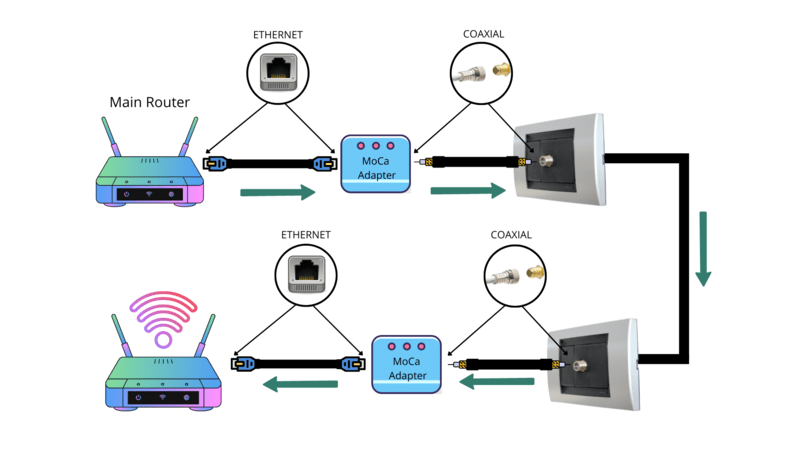
To establish the link, plug your coaxial and Ethernet cables into the adapter. The ports are usually on opposite sides, like in this ScreenBeam MoCA 2.5 Network Adapter . But they could also be on the same side, as demonstrated in this short video below:
The adapter comes in handy if the Wi-Fi signal in your room is weak or the existing cables are not long enough to extend to your workstation.
Conclusion
Coax cables were and continue to be synonymous with cable TV networks. However, with the decline in cable TV connections and TV signals now getting transmitted via Ethernet and fiber-optic cables, coaxes are on the descent.
Surprisingly, Ethernet cables are not losing sheen despite Wi-Fi becoming the standard way to access the internet on most devices. That’s probably because Wi-Fi, although convenient, is still not reliable as Ethernet.
When comparing the two, Ethernet is a communications standard or protocol, while coax is the physical cable that Ethernet may employ. That means the two are usually complementary and not competitive.
The difference between Ethernet and coax cables became pronounced after Ethernet adopted the four twisted-pair cable design, ditching the coax.
We hope this article helped you delineate the two.
Catherine Tramell has been covering technology as a freelance writer for over a decade. She has been writing for Pointer Clicker for over a year, further expanding her expertise as a tech columnist. Catherine likes spending time with her family and friends and her pastimes are reading books and news articles.

